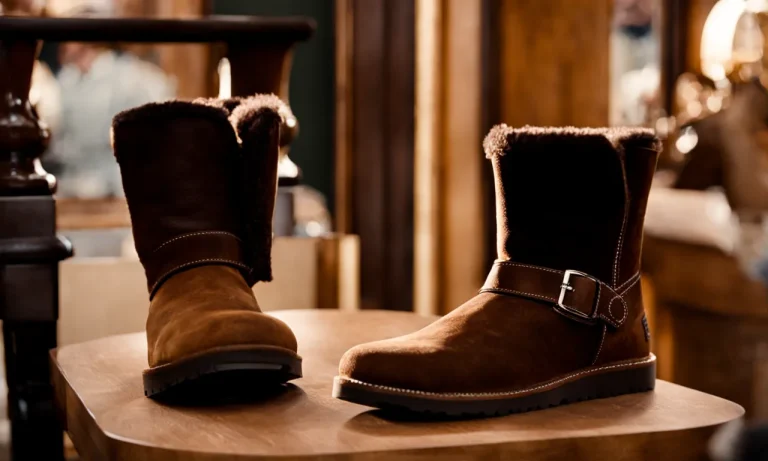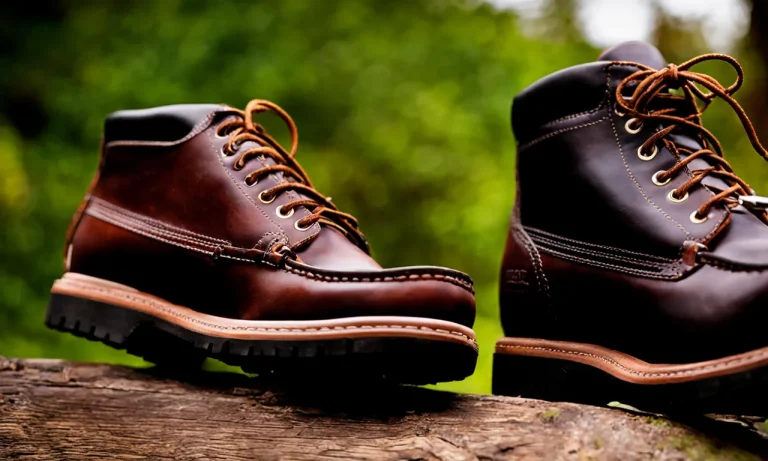Running is a popular form of exercise that can be done almost anywhere with a good pair of running shoes. But what if you want to go for a run when you’re already wearing boots, like work boots or winter snow boots? Can you run in boots or will it lead to injuries and discomfort?
This comprehensive guide will cover everything you need to know about running in boots.
If you’re short on time, here’s the quick answer: You can run in boots, but it’s generally not recommended, especially for long distances or frequent running. The stiff soles and inflexible design of most boots can put extra stress on your feet, ankles, and legs compared to proper running shoes.
Factors That Determine If You Can Run in Boots
Sole stiffness
One of the key factors that determine if you can run in boots is the stiffness of the sole. Boots with a stiff sole can hinder your natural foot movement and make it difficult to run comfortably. On the other hand, boots with a flexible sole allow for better foot flexibility and a more natural running gait.
So, when considering running in boots, it’s important to choose a pair that has a sole that offers the right balance of support and flexibility.
Ankle support
Ankle support is another crucial factor to consider when it comes to running in boots. Boots with good ankle support can help prevent sprains and provide stability during your run. Look for boots that have a higher cut or additional padding around the ankle area to ensure proper support.
It’s worth noting that while ankle support is important, it shouldn’t restrict your range of motion or feel uncomfortable during your run.
Cushioning
The amount of cushioning in your boots can greatly impact your running experience. Running involves repetitive impacts on your feet, so having adequate cushioning can help absorb shock and reduce the risk of injuries.
Look for boots that have a cushioned midsole or insole to provide a comfortable and supportive running experience. However, keep in mind that too much cushioning can also affect stability, so finding the right balance is crucial.
Weight
The weight of the boots can significantly impact your running performance. Lighter boots are generally preferred for running as they allow for more agility and faster movement. Heavier boots may slow you down and make running more challenging.
When choosing boots for running, opt for lightweight options that won’t weigh you down and allow for a more efficient running experience.
Traction
Traction is essential when running in any type of footwear, including boots. Good traction ensures that you have grip and stability on different surfaces, preventing slips and falls. Boots with a durable and grippy outsole, such as those with deep lugs or a rubber compound designed for traction, are ideal for running.
It’s important to consider the terrain you’ll be running on and choose boots that offer appropriate traction for the conditions.
Potential Problems with Running in Boots
Foot pain
Running in boots can lead to foot pain due to the lack of proper cushioning and support. Unlike running shoes that are specifically designed to absorb impact and provide adequate arch support, boots are not designed with running in mind.
The lack of cushioning can put excessive pressure on the feet, resulting in discomfort and pain.
Ankle sprains
Running in boots increases the risk of ankle sprains. Boots typically have a higher heel and a less flexible sole compared to running shoes. This lack of flexibility can make it harder to maintain stability while running, increasing the chances of rolling or twisting an ankle.
Shin splints
Shin splints, a common running injury, can also be a potential problem when running in boots. The lack of shock absorption and cushioning in boots can lead to increased stress on the shin bones, causing pain and inflammation.
Knee pain
Running in boots can also contribute to knee pain. The lack of proper cushioning and support can result in increased impact on the knees, potentially leading to discomfort or even more serious knee injuries over time.
Muscle soreness
Running in boots can lead to increased muscle soreness, especially in the lower legs. The heavier weight and lack of proper cushioning can put additional strain on the muscles, causing them to fatigue more quickly and leading to post-run soreness.
It’s important to note that these potential problems can vary depending on the type and quality of the boots, as well as individual factors such as running technique and fitness level. However, it is generally recommended to choose proper running shoes over boots when engaging in running activities to minimize the risk of these potential issues.
For more information on proper running footwear and tips for avoiding running-related injuries, you can visit reputable websites such as Runner’s World or Mayo Clinic.
Tips for Running in Boots
Choose lightweight boots
When it comes to running in boots, selecting the right pair is crucial. Opt for lightweight boots that won’t weigh you down and impede your movement. Look for boots made from materials like nylon or mesh, as they tend to be more breathable and flexible.
These types of boots will provide you with the necessary support and stability while still allowing for a comfortable running experience.
Wear thick socks
To enhance your comfort and reduce the risk of blisters, it is recommended to wear thick socks when running in boots. Thick socks provide extra cushioning and help prevent friction between your feet and the boots.
This can make a significant difference in your overall running experience and help you avoid discomfort and potential foot injuries.
Loosen laces
Before you start running in boots, make sure to loosen the laces. Tight laces can restrict blood flow and cause discomfort. Loosening the laces will give your feet more room to move and allow for better flexibility.
However, be cautious not to loosen them too much, as you still need adequate support and stability during your run.
Stretch before and after
Just like with any other physical activity, it’s essential to stretch your muscles before and after running in boots. Stretching helps warm up your muscles, increases flexibility, and reduces the risk of injury.
Focus on stretching your calves, quads, hamstrings, and ankles to prepare your body for the impact of running in boots.
Run on soft surfaces
When possible, choose to run on soft surfaces such as grass or dirt trails. Running on hard surfaces like concrete or pavement can put added strain on your joints and increase the risk of injury. Soft surfaces absorb impact better and provide a more forgiving running experience.
If you don’t have access to soft surfaces, consider investing in insoles that provide additional cushioning and shock absorption.
Start slow and low mileage
Running in boots can be more challenging than running in regular running shoes. To avoid overexertion and potential injuries, it’s important to start slow and gradually increase your mileage. Begin with shorter distances and lower intensities, allowing your body to adapt to the new demands.
Gradually increase the duration and intensity of your runs over time as your body becomes more accustomed to running in boots.
Best and Worst Boots for Running
Hiking boots
Hiking boots can be a good option for running if you are going off-road or tackling rough terrains. These boots are designed to provide stability and support to your feet, which can be beneficial for trail running. Look for hiking boots with a flexible sole and cushioning to absorb impact.
Popular brands such as Merrell and Salomon offer a wide range of hiking boots that are suitable for running as well.
Work boots
Work boots, on the other hand, are not recommended for running. These boots are typically heavy and lack the flexibility and cushioning needed for running. They are designed for protection and safety in hazardous work environments.
If you need to run during your workday, it’s best to invest in a separate pair of running shoes for optimal comfort and performance.
Winter boots
Winter boots are designed to keep your feet warm and dry in cold and snowy conditions. While they may provide insulation, they are not ideal for running due to their heavy construction and limited flexibility. Running in winter boots can be challenging and may increase the risk of injury.
It’s better to opt for lightweight and breathable running shoes specifically designed for winter running.
Cowboy boots
Cowboy boots are stylish and iconic, but they are not suitable for running. These boots have a high heel and a narrow toe box, which can restrict movement and cause discomfort while running. Cowboy boots are designed for horseback riding and fashion, not for athletic activities.
If you’re looking to go for a run, it’s best to choose a pair of running shoes that provide the necessary support and comfort.
Rain boots
Rain boots, also known as Wellington boots or galoshes, are waterproof boots designed to protect your feet from rain and wet conditions. While they may keep your feet dry, they are not designed for running. Rain boots are typically heavy and lack the cushioning and flexibility needed for running.
If you need to run in rainy conditions, consider investing in a pair of waterproof running shoes that provide both protection and performance.
Conclusion
While it’s possible to run in boots, especially for short distances, it’s generally not recommended as the best option for regular running. The rigid soles and inflexible design can put more stress on your feet, ankles and legs compared to proper running shoes.
If you want to start running regularly for exercise and performance, invest in a good pair of running shoes fitted for your foot type. But for the occasional short run in boots, just take it slow and listen to any pain or discomfort signals from your body.






